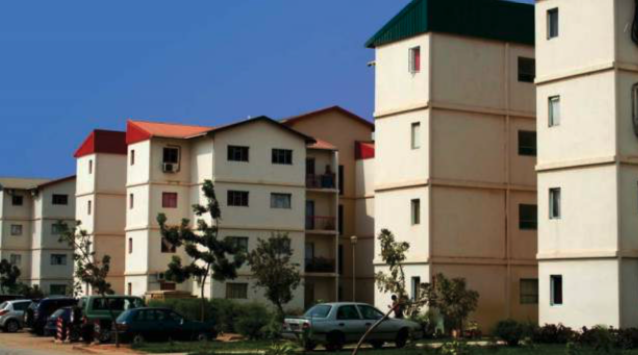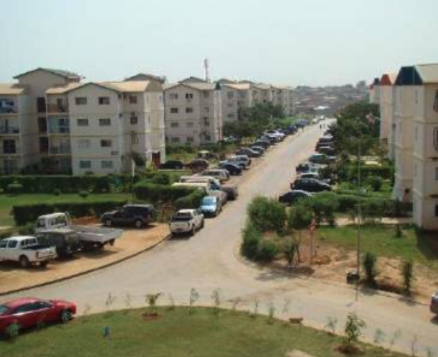Building Happy and Integrated Neighbourhoods in Luanda, Angola

Key Messages
- In Luanda, Angola, up to an estimated 10% of residents are at risk of losing their homes due to flooding and erosion.
- A big challenge that this project faced was negotiating with the Angolan Government which was required to promote the eco-town approach.
- This case study is a good example of how eco-town planning can create environmentally and socially resilient communities through innovation in addressing future climate risks
Introduction
This case study is from theFRACTAL Adaptation Inspiration Book– this link provides a summary of the book, the other case studies and a downloadable pdf.
Rapid urbanisation and the scourge of a 27-year long civil war have resulted in dramatic housing shortages in Luanda. The government has responded by appointing Chinese contractors to build high density housing.
The Nova Vida Housing Development is a large housing development project undertaken for the Angolan government, in an attempt to improve on the ‘bedroom estates’ that have been created.
The FRACTAL Adaptation Inspiration Book contains a variety of case studies which are related to this case study, examining adaptation of infrastructure, settlements and waste management. The related articles can be found here:- Stakeholder-Based Development Planning of the Shire River Basin’s Water and Natural Resources in Southern Malawi
- Improved Waste Management through Public-Private Partnerships in Lusaka
- Maputo, Mozambique: Private-Public-People networks for climate compatible development addressing adaptation and disaster risk
- Lusaka, Zambia: Building disaster risk reduction and emergency response to flooding
- Community-Based Action against Flood Risks in Dakar
Climate Risks and Other Stressors
Years of war in Angola drove large numbers of people from conflict-affected inland areas to the relative safety of coastal cities. Many of them eventually settled in informal communities on marginal, environmentally fragile and low-cost land prone to flooding and landslides in Luanda.
Climate change is exacerbating these hazards by increasing average temperatures, shortening drought cycles, and leading to concentrated periods of higher rainfalls. This variability is further heightened in coastal areas, which are subject to isolated and extreme storm events releasing large volumes of rain.
These storms have particularly severe consequences for the vulnerable populations living in these areas. Up to an estimated 10% of residents are at risk of losing their homes due to flooding and erosion.
Adaptation Approach

The Nova Vida urban park in Luanda, Angola, is a flagship project for the integration of green spaces into urban development planning for Africa. It can be described as an adaptation approach that is climate-proofing the built environment.
The park provides a total of 6,000 residential units and 400,000m2 of retail and office space. The green spaces included in the plan function both as recreational areas and as areas of small-scale cultivation, which reduces the climate risk to the park. These spaces enhance the natural beauty and environmental quality of the park, and they have positive effects on runoff and flood management.
Links to SDGs

The Nova Vida Park aligns with Goals 2, 3, 11, and 13 of the SDGs. Through the use of spatial planning, the park has specifically designed green belts that allow for urban farming (of crops such as maize or cassava, etc.) addressing Goal 2. In addition, the green belts assist with the drainage in the housing development, ensuring that people in Luanda can cope with highly variable rainfalls. Safe, well-built housing with sanitation and water quality assists with Goal 3 on good health and well-being. In addition, the Nova Vida Park has generated a local economy with various shopping activities developing in and around the park, which contribute to Goal 11 in developing economically, environmentally and socially sustainable cities and communities. The people centred development addresses climate change impacts through its flood management.
Challenges
This project faced four challenges:
- Negotiation with the Angolan Government was required to promote the eco-town approach and describe the benefits of planning which supports resilient communities.
- Sourcing and transport of durable and suitable materials for the project proved difficult.
- Language proved to be an issue, with a multinational and multilingual workforce; designers of Nova Vida spoke a different language than the contractor, for instance.
- The relatively unskilled local workforce required on-site skills training and mentoring.
Benefits
Trees, green spaces and areas of water can significantly cool the built environment and save energy. They can also have health benefits for the Nova Vida communities, and provide a space for urban farming and cultivation. In this way, the design of the park encourages the interlacing of housing and subsistence food production, enabling food security for the resident community.
The Nova Vida Park provides housing for 30,000 people. The park’s infrastructure facilities also provide room for: future community facilities, parks, schools, churches, technical colleges, a university, clinics, shopping centres, a retail complex, office accommodation, light industrial stands, and town management offices. Furthermore, a primary school, police station, a convention centre and sports centre were constructed under separate contracts during phase 1.
Lessons Learnt
Nova Vida offers a prime example of what can be achieved, in collaboration between government and consultants, through innovation in addressing future climate risks and the practical needs of the client, in this case the Angolan government.
The government of Angola’s vision for 2018-2025 (Ministério da Energia e Águas, 2016), with the ambition of ‘transforming Angola into a prosperous, modern, poverty free country…’, sets a precedent for similar, future developments throughout the country and elsewhere in Africa.
Related resources
- Nova Vida, Angola - Aurecon
- FRACTAL website
- Stakeholder-Based Development Planning of the Shire River Basin’s Water and Natural Resources in Southern Malawi
- Improved Waste Management through Public-Private Partnerships in Lusaka
- Maputo, Mozambique: Private-Public-People networks for climate compatible development addressing adaptation and disaster risk
- Lusaka, Zambia: Building disaster risk reduction and emergency response to flooding
- Community-Based Action against Flood Risks in Dakar
(0) Comments
There is no content